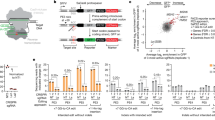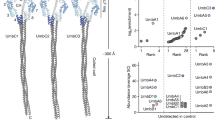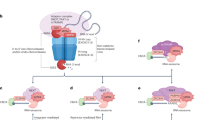Abstract
We have analysed the interaction of the trp represser with the trpEDCBA operator using a series of modified trp operator sequences incorporating two isosteric purine analogues that lack N7–nitrogens. Our results suggest that as well as the direct contact between Arg69 and G−9, three additional purine N7–nitrogens, implicated in specific, water–mediated contacts to the represser, are critical for formation of the high–affinity represser–operator complex. We conclude that the crystal structure obtained by Otwinowski et al. reflects high–affinity sequence–specific binding of the trp represser to the trp operator, and that in some cases proteins can use water molecules to extend amino acid side chains in order to derive favorable binding energy in complex formation.
This is a preview of subscription content, access via your institution
Access options
Subscribe to this journal
Receive 12 print issues and online access
$189.00 per year
only $15.75 per issue
Buy this article
- Purchase on Springer Link
- Instant access to full article PDF
Prices may be subject to local taxes which are calculated during checkout
Similar content being viewed by others
References
Otwinowski, Z. et al. Crystal structure of the trp represser/operator complex at atomic resolution. Nature 335, 321–329 (1988).
Kumamoto, A.A., Miller, W.G. & Gunsalus, R.P. Escherichia coli tryptophan represser binds multiple sites within the aroH and trp operator. Genes Dev. 1, 556–564 (1987).
Carey, J. Trp represser arms contribute binding energy without occupying unique locations on DNA. J. biol. Chem. 264, 1941–1945 (1989).
Bass, S., Sugiono, P., Arvindson, P.W., Gunsalus, R.P. & Youderian, P. DNA specificity determinants of Escherichia coli tryptophan represser binding. Genes Dev. 1, 565–572 (1987).
Kelly, R.L. & Yanofsky, C. Mutational studies with the trp represser of Escherichia coli support the helix-turn-helix model of represser recognition of operator DNA. Proc. natn. Acad. Sci. U.S.A. 82, 483–487 (1982).
Bass, S., Corrills, V. & Youderian, P. Mutant trp represser with new DNA-binding specificities. Science 242, 240–245 (1988).
McClarin, J.A. Structure of the DNA Eco RI endonuclease recognition complex at 3 Å resolution. Science 234, 1526–1541 (1986).
Anderson, J.E., Ptashne, M. and Harrison, S.C. Structure of the repressor-operator complex of bacteriophage 434. Nature 326, 846–852 (1987).
Clarke, N.D., Beamer, L.J., Goldberg, H.R., Berkower, C. & Pabo, C.O. The DNA binding arm of a delta represser: critical contacts from a flexible region Science 267, 267–270 (1991).
Brennan, R.G. & Matthews, B.W. The helix-turn-helix binding motif. J. biol. Chem. 264, 1903–1906 (1989).
Staacke, D., Walter, B., Kisters-Woike, B.V., Wilcken-Bergmann, B. & Muller-Hill, B. How trp represser binds to its operator. EMBO J. 9, 1963–1967 (1990).
Marmorstein, R.Q., Sprinzl, M. & Sigler, P.B. An alkaline phosphatase protection assay to investigate trp repressor/operator interactions. Biochemistry 30, 1141–1148 (1991).
Carey, J., Lewis, D.E.A., Lavoie, T.A. & Yang, J. How does trp represser bind to its operator. J. biol. Chem. 266, 24509–24513 (1991).
Haran, T.E., Joachimiak, A. & Sigler, P.B. The DNA target of the trp represser. EMBO J. 11, 3021–3030 (1992).
Seela, F. & Driller, H. Palindromic oligonucleotides containing 7-deaza-2′-deoxyguanosine: solid phase synthesis of d[(p)GG*AATTCC] octamers and recognition by endodeoxyribonuclease Eco RI. Nucleic Acids Res. 14, 2319–2333 (1986).
Mazzarelli, J.M., Rajur, S.B., Iadarola, P.I. & McLaughlin, L.W. The interactions between the trp represser and its operator sequence as studied by base analogues substitution. Biochemistry 31, 5925–5936 (1992).
Klig, L.S., Crawford, I.P. & Yanofsky, C. Analysis of trp repressor-operator interactions by filter binding. Nucleic Acids Res. 15, 5339–5351 (1987).
Marmorstein, R.Q. & Sigler, P.B. Stereochemical effects of L-tryptophan and its analogues on the repressor's affinity for operator DNA. J. biol. Chem. 264, 9149–9154 (1989).
Carey, J. Gel retardation at low pH resolves the trp repressor-DNA complexes for quantitative study. Proc. natn. Acad. Sci. U.S.A. 85, 975–979 (1988).
Fersht, A.R. The hydrogen bond in recognition. TIBS 12, 301–304 (1987).
Fersht, A.R. Hydrogen bonding and biological specificity analyzed by protein engineering. Nature 314, 235–238 (1985).
Street, I.P., Armstrong, C.R. & Wither, S.G. Hydrogen bonding and specificity. Fluorodeoxy sugars as probes of hydrogen bonding in the glycogen phosphorylase-glucose complex. Biochemistry 25 6021–6027 (1986).
Aiken, C.R. & Gumport, R.I. Restriction endonucleases. Methods Enzymol. 208, 433–457 (1991).
Record, M.T. Unusual DNA structures. (ed. Wells, R.D. & Harvey, S.C.) 237–252 (Springer, New York, 1988).
Luisi, B.G. & Sigler, P.B. The stereochemistry and biochemistry of the trp repressor-operator complex. Biochem. biophys. Acta. 1048 113–126 (1990).
Seela, F. & Kehne, A. Palindromic octa- and dodecanucleotides containing 2′-deoxytubercidin: synthesis, hairpin formation and recognition by endodeoxyribonuclease Eco RI. Biochemistry 26, 2232–2238 (1987).
Matteucci, M. & Caruthers, M.H. Synthesis of deoxynucleotides on a polymer support. J. Am. Chem. Soc. 103, 3185–3191 (1981).
McLaughlin, L.W. & Piel, N. Chromatographic purification of oligonucleotides, in Oligonudeotide synthesis, a practical approach (ed. Gait, M.J., 199–218 IRL Press, Oxford, 1984).
Lawson, C.L. & Carey, J. Tandem binding in crystals of a trp repressor/operator half-site complex. Nature 366, 178–182 (1993).
Author information
Authors and Affiliations
Rights and permissions
About this article
Cite this article
Smith, S., Rajur, S. & McLaughlin, L. Specific purine N7-nitrogens are critical for high affinity binding by the trp repressor. Nat Struct Mol Biol 1, 18–22 (1994). https://doi.org/10.1038/nsb0194-18
Received:
Accepted:
Issue Date:
DOI: https://doi.org/10.1038/nsb0194-18
This article is cited by
-
Solution structure of a DNA duplex containing a replicable difluorotoluene–adenine pair
Nature Structural Biology (1998)
-
Mutants in position 69 of the Trp repressor ofEscherichia coli K12 with altered DNA-binding specificity
Molecular and General Genetics MGG (1996)



